Parmigiano Reggiano, one of the first examples of the Made in Italy brand
A visit to a Parmigiano Reggiano dairy | The three ingredients (plus two) that make Parmigiano Reggiano unique
A few days ago, we went to Parma, in Emilia Romagna, to attend a guided tour of a dairy farm belonging to the Parmigiano Reggiano Consortium. You step into the cheese-making room in the early morning, just when the evening milk, that has been resting in large vats overnight, is mixed with the fresh morning milk. You have the chance to stand next to the cheesemaker, who skilfully doses whey culture and calf rennet, and then gently touches the curd to tell from the ripples when it is ready.
We had the opportunity to experience this enlightening guided tour invited by the Consortium, but you too can take part in the magic that has been repeated unchanged for centuries and see how Parmigiano Reggiano is made. And you can easily book a visit and a tasting on the consortium's website.
It is here that you realise that one of the most representative products of the Made in Italy brand, one of the best known, loved and most imitated, is an artisanal product that encapsulates the essence of a territory, its scents, and its craftsmanship.
To bear the designation Parmigiano Reggiano PDO, the cheese has to be made respecting strict rules. First of all, it has to be produced in the Area of origin, a surface of approximately 10,000 km2 which includes the provinces of Parma, Reggio Emilia, Modena, Mantua to the right of the Po river, and Bologna to the left of the Reno River.
Territoriality is so important that not only the milk must be produced in this area of origin, but also at least 75% of the fodder that feeds the cows. The processing into cheese, the maturation until a minimum age of 12 months, the packaging and the grating of Parmigiano Reggiano PDO have also to take place exclusively in the area of origin. The same rules also dictate the production methods of Parmigiano Reggiano, which often refer to millenary traditions.
During a visit to a cheese farm, you can experience all of this, from the importance of tradition to the central role of the land. These are experiential visits that, just like the final tasting of Parmigiano Reggiano, activate and tickle all five senses.
The dairy farm tour
We arrived just before 8 am at the San Pier Damiani Dairy Farm, in the province of Parma, on a blindingly white summer morning. Around the dairy are the stables and pastures where the Friesian and Alpine Brown cows that produce the milk for the cheese are reared.
The Delsante family has been involved in agriculture for six generations, and today it is Elvezio Delsante and his son Saverio who run the family business. Visits and hospitality are managed by his daughter-in-law Roberta and his wife Amalia, an Italian and history teacher who was the first one to open the doors of the dairy, more than ten years ago, to show, with transparency and justifiable pride, what lies behind every single wheel of Parmigiano Reggiano.
Once we had donned overalls and shoe covers, we entered the dairy armed with a camera, a notepad, and a fair amount of curiosity. There, the smells of milk and hay, the precise gestures, repeated day after day with the same expertise, and the different temperatures that mark the life of Parmigiano Reggiano transported us to an artisanal reality with centuries of history behind it.
The history
Parmigiano Reggiano was born in the Middle Ages, in the 12th century, when the Cistercian monks, in the spirit of the Benedictine Ora et Labora, dedicated themselves to prayer as much as manual labour. Parmigiano Reggiano was produced with the aim of preserving milk for a long time. The large wheels also allowed Parmigiano Reggiano to travel, moving away from its area of production, becoming one of the first examples of Made in Italy.
The three ingredients (plus two) that make Parmigiano Reggiano unique
What makes Parmigiano Reggiano so unique? Only three ingredients (milk, calf rennet, salt) are needed, along with two other fundamental elements: it all starts with the stables and meadows where cows are reared and ends with the action of time.
During our visit to the San Pier Damiani dairy farm, we had the chance to witness the entire process.
1) The stables and meadows
Just as in the case of a good wine, which is usually made not only in the cellar but above all in the vineyard, a quality cheese such as Parmigiano Reggiano is not only made in the dairy farm, but also in the stables and meadows.
The uniqueness of Parmigiano Reggiano begins on the farms, where cows are fed exclusively with forage, grass, and hay from the area, in a protected environment.
Specifications establish that the use of fermented feed is absolutely forbidden to feed cattle. Therefore, the use of silage feed is forbidden, whilst this is largely used in other parts of Italy. This means that the only three ingredients of Parmigiano Reggiano are milk, calf rennet, and salt, as no additives are required in the production of Parmigiano Reggiano: actually, they are absolutely forbidden.
2) The milk
According to the specifications, the milk of Parmigiano Reggiano must be produced exclusively in its area of origin. 90% of the milk comes from Friesian cows, while the remaining 10% comes from Alpine Brown Cows (in the province of Parma), Red Cows (Reggio Emilia), and White Cows (Modena).
The milk from the evening milking is left to rest until morning in large vats, where the fatty part spontaneously rises to the surface. This is used for the production of butter and cream. The next day, the evening milk, thus skimmed, is poured into the upturned bell-shaped copper cauldrons and is processed together with the whole milk from the morning milking, freshly delivered from the farms.
This is when siero innesto, whey culture, comes in, a culture of bacteria left over from the previous day's cheese-making process.
Imagine the whey culture as a kind of 'sourdough starter', which allows the local population of lactic acid bacteria to contaminate and characterise the cheese produced each day.
The amount of whey culture used varies from day to day, depending on its acidity and the acidity of the milk, and this makes each wheel of Parmigiano Reggiano different from the other.
Once mixed, the milk is heated to 35-36°C / about 95°F.
3) The calf rennet
When the milk reaches 35-36°C/about 95°F, the cheesemaker adds the calf rennet1 [this makes Parmigiano Reggiano, and any other cheese made with animal rennet, potentially unsuitable for those on a vegetarian diet].
In about 15 minutes, the milk begins to curdle, and the cheesemaker gently touches the curd to understand from its ripples when the time is right to do the spinatura, the breaking of the curd. Observing this moment on the dairy farm, one cannot help but feel a thrill of emotion, as this simple gesture brings out not only the artisanal character of the product but above all the importance of the cheesemaker's experience and craftsmanship.
The first movements to break the curd are always done by hand using a traditional tool known as spino [from biancospino, hawthorn, whose hardwood was once used to execute this fundamental process]. They are important for the cheesemaker to understand and check the cheese-making process. The subsequent mechanical spinning causes the curdled milk, now reduced to small granules the size of grains of rice, to separate from the whey.
From milk to cheese After cooking for about 10 minutes and resting for 45 minutes, curd granules collect at the bottom of the cauldron, forming a compact mass. Each cauldron, filled with 1,000 litres of milk, will produce 2 wheels of 50 kg each. This is perhaps the most moving and poetic moment. The cheesemaker and one of his assistants, with quick and precise movements, first collect the mass in a linen cloth, and then divide it by hand into two parts, known as twins. Before being placed in the cheese mould that will give it its final shape, a casein plate with a QR code, a sort of identity card, a unique, sequential alphanumeric code, is applied to each cheese wheel. This allows the Consortium to trace each cheese wheel back to the cheese vat, the milk, the barn, and what the cows ate. Removed from the cauldron, the cheese, wrapped in linen cloths, is placed in the moulds, known as fascera, to take its cylindrical shape, is turned over every two hours to lose the whey. At the end of the first day, once the linen cloth has been removed, the branding band is applied overnight. It will imprints the month and year of production, the identification number of the dairy and the unmistakeable dotted inscription. It is at this moment that the visual identity of Parmigiano Reggiano is born. The cheese then rests for two days inside the metal mould to take its shape.
And what about the whey that is left behind?
A small part of the whey becomes siero innesto, whey culture.
Part of the whey is used to make ricotta. They add salt and then reheat the whey to 90°C/195°F, hence the name ri-cotta, re-cooked. Sometimes they also add whole milk, or the cream skimmed from the milk of the previous night to make the ricotta richer.
In the past, whey was mainly destined to become food for pigs, in a circular economy that saw pig farming - and the consequent production of cured meats - closely linked to the work of dairies.
Today, whey is also sold to the pharmaceutical, cosmetic, and food industries.
Since whey quickly becomes very acidic, it is often used to clean and disinfect the cheese-making room, so that the bacteria contained in the whey can contaminate all surfaces, contributing to the creation of the unique microbiological environment that allows the birth of Parmigiano Reggiano.
4) The salt
We now move to the brine room, where the fourth ingredient, salt, comes into play.
Once the branding band has been removed, each wheel is then immersed in a solution of water and natural salt for 20 days, to conclude the production process with salting by absorption.
It is the salt, a natural preservative, that makes Parmigiano Reggiano cheese last for a long time.
5) The time
Time is an essential intangible ingredient in the production of Parmigiano Reggiano PDO, just like the craftsmanship of the cheesemaker.
The wheels of Parmigiano Reggiano must mature in a warehouse in the territory of origin for at least 12 months, until the Consortium's experts inspect the cheeses, one by one, and then fire-brand them. This is the most crucial stage for consumers: the moment of selection and of certification of the product that provides an absolute guarantee of its quality.
Thanks to its production process, the Parmigiano Reggiano is also naturally lactose free already 48 hours from production since all its sugar (lactose) is transformed into lactic acid by lactic bacteria
Now, Parmigiano Reggiano PDO can be sold, or it can continue its maturing process. There is no time limit to the maturing process, so much so that some wheels reach up to 100 months.
The tasting of Parmigiano Reggiano
The visit to the dairy farm ends with a tasting session, that once again involves the five senses. Parmigiano Reggiano must be tasted at room temperature, first paying attention to its colour and grain, then breaking it up with your hands to smell its aromas.
In the mouth, we need to focus on taste (is it sweeter? or saltier?), aromas (butter, milk, yoghurt, but also vegetable notes of grass or boiled vegetables, the aroma of meat stock or spices such as nutmeg) and texture (pay attention to it granularity, crumbliness, and solubility).
As Parmigiano Reggiano matures, clearly visible tyrosine crystals form, which crackle in the mouth, affecting even the last sense involved, hearing.
Have you ever noticed how much Parmigiano Reggiano varies as it matures? Do you have a favourite type of Parmigiano Reggiano?
Fun facts about Parmigiano Reggiano
Parmigiano Reggiano crust. The rind of Parmigiano Reggiano is edible and very precious. As is not chemically processed during production, just brush it well before consuming it. Add it to stock and soups, or eat it fried, or microwaved.
Parmigiano Reggiano in the space. In addition to athletes, Parmigiano Reggiano is also recommended for astronauts! In 2005, Parmigiano Reggiano was included in the official diet of all astronauts on missions to the International Space Station.
Parmigiano Reggiano and banks. Historically, cheeses were used as a guarantee to obtain loans from banks. Even today, many maturing warehouses are often owned by local banks.
How to store Parmigiano Reggiano. When you buy a piece of Parmigiano Reggiano freshly cut or when you take it out of the vacuum pack, it must be stored in the refrigerator at a temperature ranging from 4 to 8°C, wrapped in food-grade film, or, even better, in Ovtene bags. Keep it away from other foods because the fatty part of cheese tends to absorb all smells.
Where to buy Parmigiano Reggiano in the US?
At Eataly, you can find the Parmigiano Reggiano produced directly by the dairy farms belonging to the Consortium.
The Valserena dairy farm ships overseas.
For online purchases: Zabars.com, Zingermans.com, Murrayscheese.com.
And remember! Parmigiano Reggiano is one of the most imitated products in the world!
If you want to be sure that you are buying the real deal, the one and only, check that the cheese has been produced in Italy. Moreover, the label of the product has to include the certification logo “Parmigiano Reggiano piece and wheel” and, since April 2018, the cheese pieces have to specify the minimum maturation in addition to the PDO symbol and the wording of the certification by the Italian Ministry of Agriculture (Mipaaft).
If you have read this far, thank you! Share this email with anyone you think might be interested, let us know in the comments what struck you most about this visit, subscribe, or give a gift subscription to Letters from Tuscany!
Rennet is obtained from the stomach of suckling calves (bacterial rennet is forbidden).




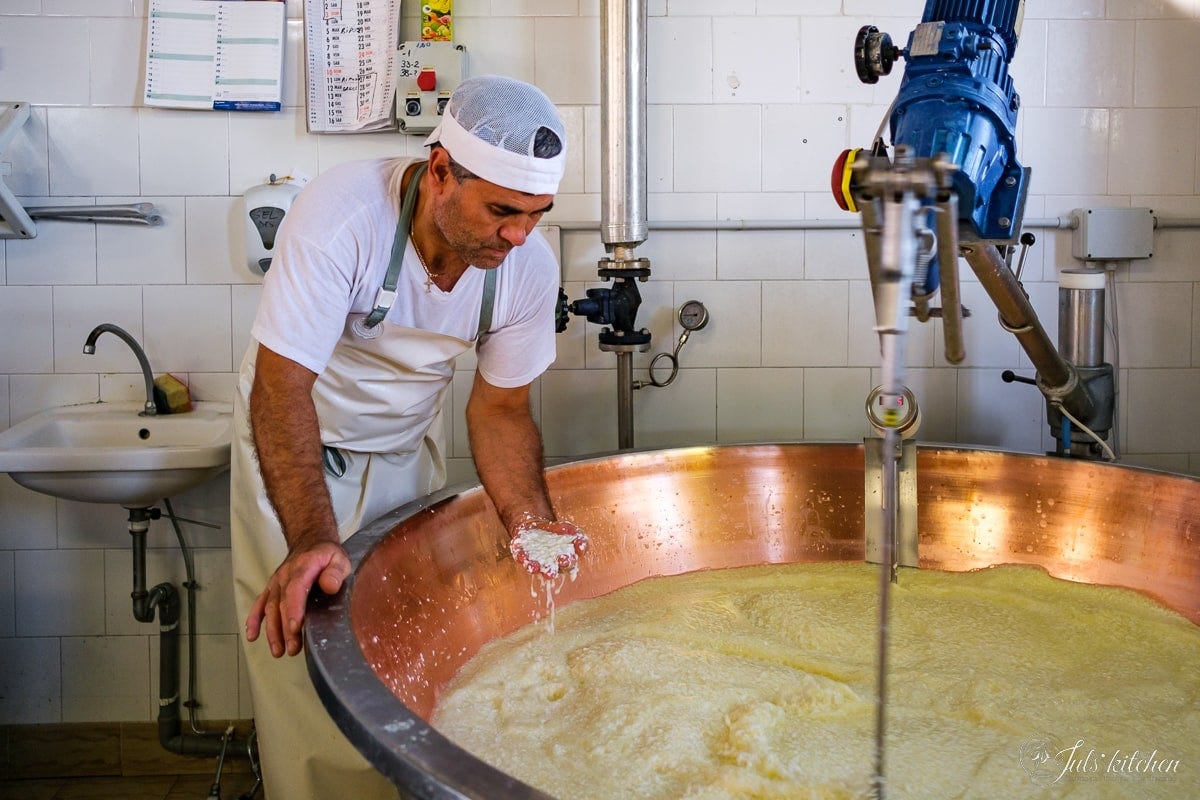

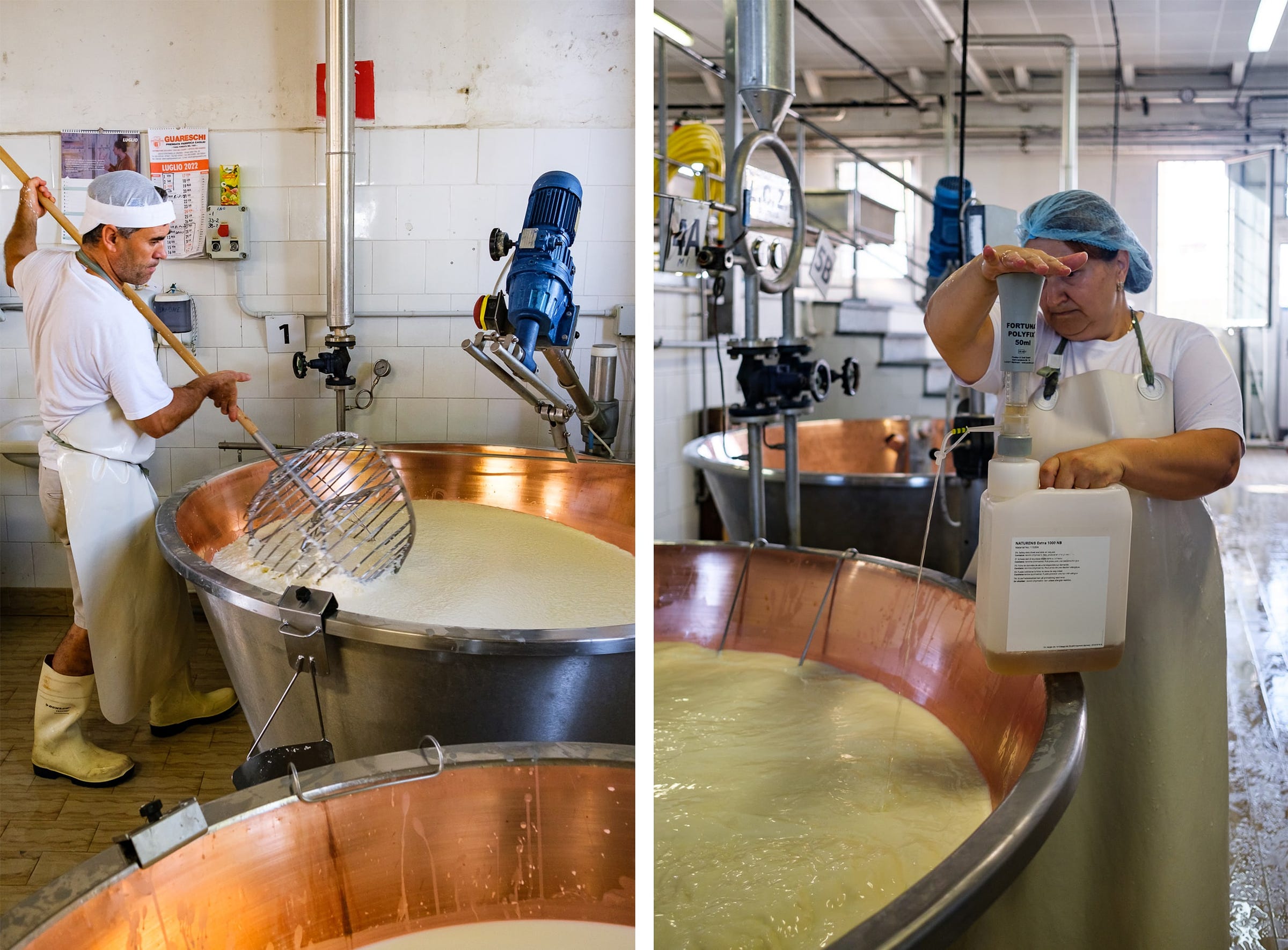
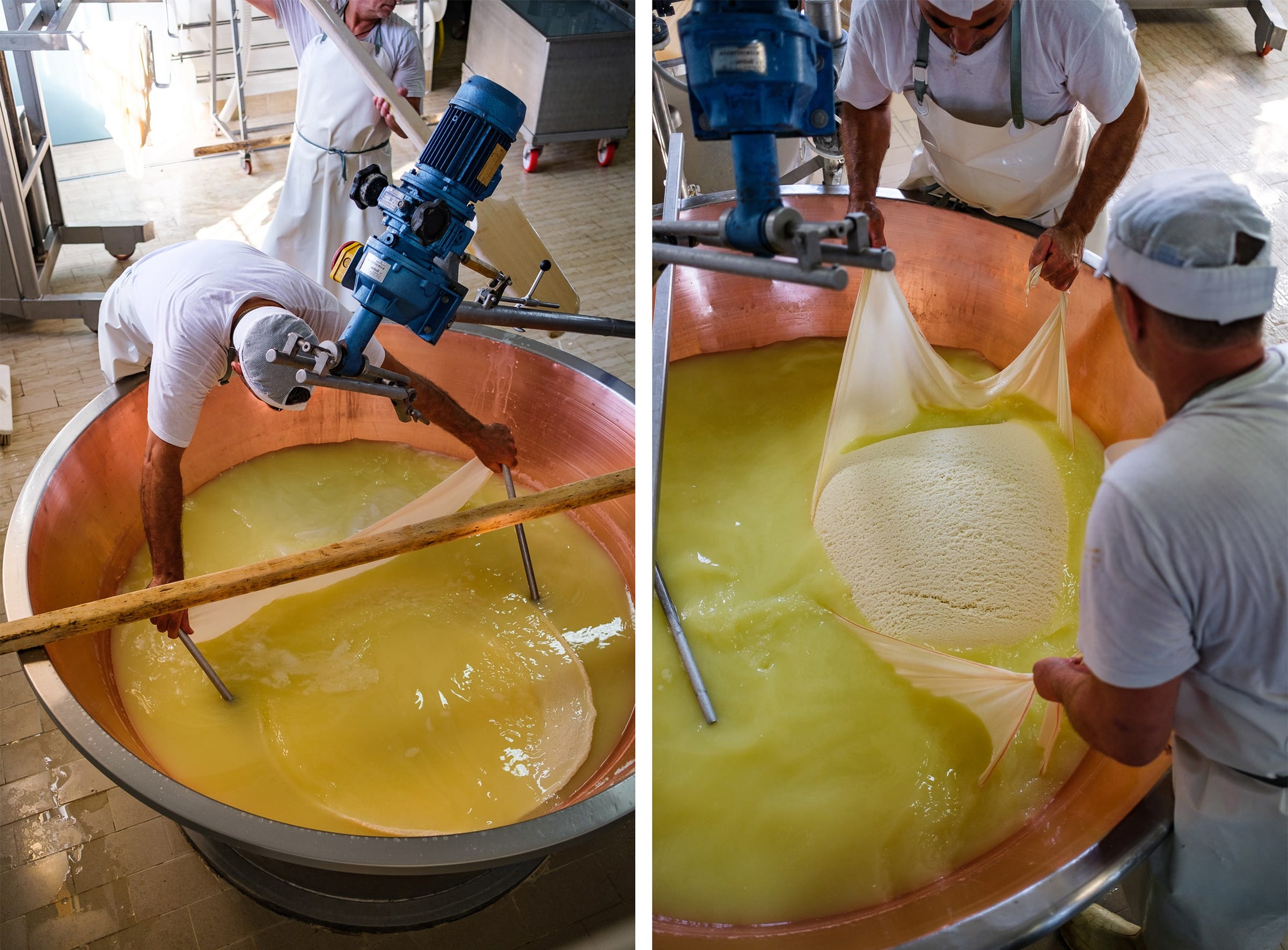


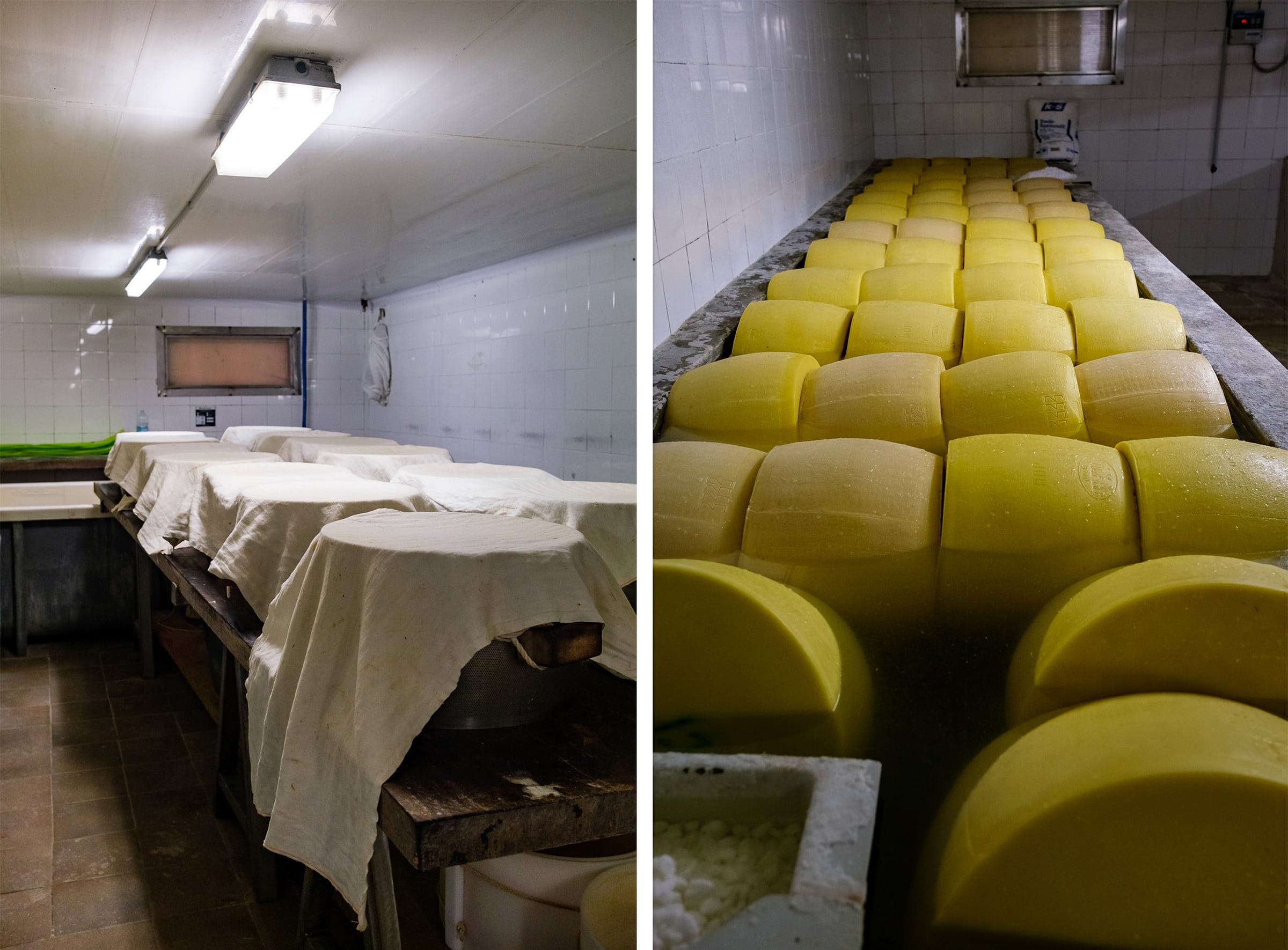

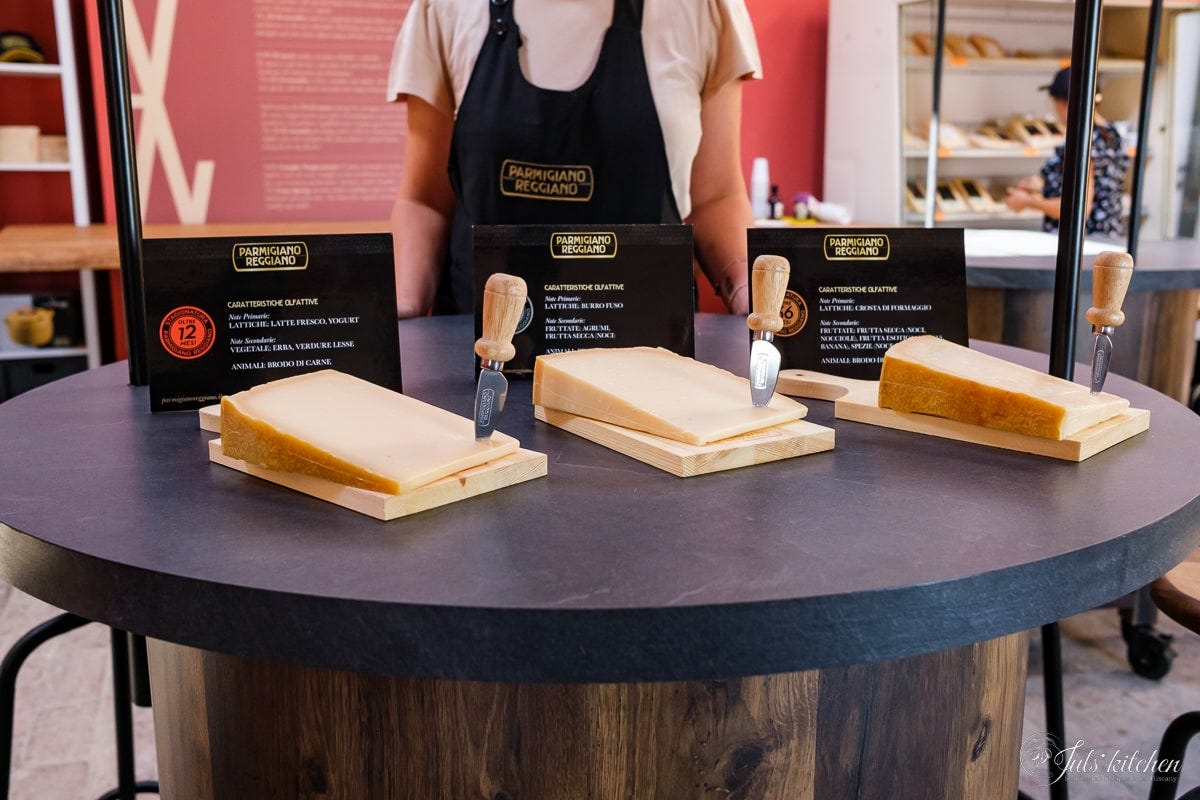
A very informative and detailed process of production for this king of cheeses. Thank you!
One of my favorite cheeses. And now I know so much more about it. Thank you Giulia.